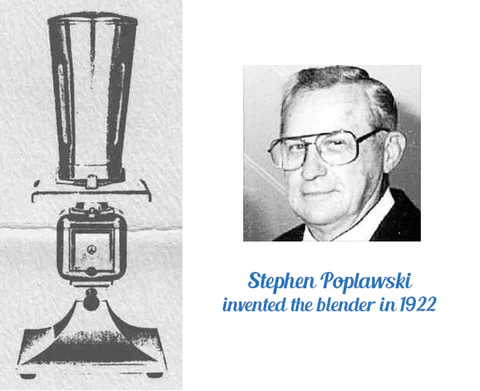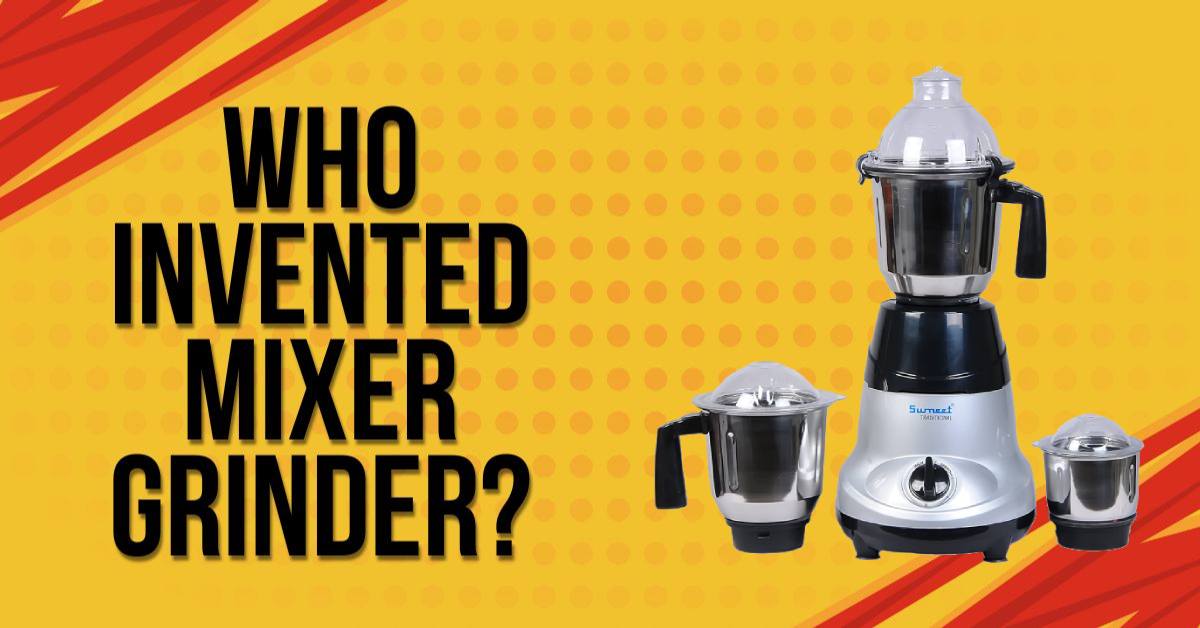When it comes to kitchen work, the mixer grinder has changed the nature of the tasks by making them less time-consuming and easier to perform; functions like grinding, mixing, and blending.
But Who Invented Mixer Grinder and how did it develop into such an essential kitchen item?
The development of the mixer grinder spans decades up to the latest times, thanks to the efforts of inventors and well-known brands, for instance, the Indian brand, Sumeet, that localized it.
We can say this invention of the mixer grinder is more flexible, doing more than just mixing.
In this article, we will try to help you do just that – recover the history of mixer, the various people who contributed to its invention, and the significant events of its history.
Let’s find out how this tool became an indispensable tool in our contemporary kitchens.
Who Invented Mixer Grinder?
As it can be observed today, there is no single inventor that can be attributed to the development of the mixer grinder.
It rather came up through modification and creation by several inventors who came up with early versions of the mixing and grinding appliances.
A significant advancement was seen in 1908 when Herbert Johnston of the Hobart Manufacturing Company invented the very first stand-electric mixer.
Even if this was not quite a mixer grinder as we understand, this invention was still very important as it started the trend of electrical mixing in the kitchen and designing future appliances.
Further development of the idea was made in 1922 by Stephen Poplawski, who patented the first electric blender which was specially designed for making milkshakes, and this opened the doors to the creation of multi-functional blending and grinding appliances.
Also Read: Ultimate Mixer Grinder for Gym Lovers
The Early Days of Food Grinding
The evolution of the mixer grinder begins with primitive grinding devices that composed food in the past periods.
For example, the mortar and pestle made out of stone or wood were used for pounding and grinding grains, leaves, or different kinds of spices.
To be sure, these devices worked effectively, however, they required a lot of manual effort and took a significant amount of time.
Following these, the concept of a mechanical means to assist in the food process was introduced, where the handing of one’s food also required less work to be done with both the grinding and the mixing of food items.
Manual to Mechanical Grinding Tools
This increased interest in cooking and home management, leading to the invention of egg beaters in 18th century France, and blenders and food processors in the 1900’s.
In the early 1800’s inventors began creating hand appendages or cranked grinders which employed human mechanics and were primarily employed for artisan crafts of grinding grains and coffee beans.
Such hand-powered devices signaled the dry opening of the way towards the preparation of food more easily. One such tool was the egg beater and wire whisk, which became popular among bakers for mixing up the necessary ingredients.
Invention of the Egg Beater and Wire Whisk
The egg beater and wire whisk were the first tools to make mixing in the kitchen easier. These were the start of efficient food prep tools, making tasks like beating eggs, mixing batters, and whipping cream a breeze.
The first egg beater was patented in 1856 by Ralph Collier in Baltimore, Maryland. This hand-cranked device had gears that turned multiple beaters, reducing the time and effort to whip ingredients.
The egg beater was an instant hit for baking and other kitchen tasks.
Meanwhile, the wire whisk was invented in 19th century France and was used by bakers. Unlike egg beaters, wire whisks relied on manual wrist movement and were for smaller mixing tasks.
The whisk’s open design allowed air to incorporate smoothly, perfect for whipping eggs and cream.
These early tools set the stage for modern kitchen appliances like mixer grinders and blenders to change the way food is prepared in kitchens everywhere.
Who Invented the Hand Mixer?
As we know, there was a hand mixer, although it had not yet reached its final form. The rotary egg beater was invented by Ralph Collier in 1856, who created and patented a hand-cranked rotary egg beater driven by a system of gears.
It was a good idea to design it this way because a hand-cranked system will allow for several beaters to be rotated efficiently about the hand crank, paving the way for future developers who work on hand mixers.
Then, in the first decades of the 20th century, the electric hand mixer was born – it relied on technological advances in motor development which permitted hand-held appliances that didn’t need to be cranked manually.
The popularization of electric hand mixers commenced with companies like Sunbeam which released their first product of this kind in 1952.
Together with its counterparts, this invention paved the way for innovations in baking and cooking, because it made mixing, for example, significantly faster and easier for amateur chefs.
Nowadays, the hand mixer is considered a common item in the kitchen, because of its efficiency and the convenience available due to inventors like Ralph Collier and brands including Sunbeam.
Key Innovators and the First Electric Mixers
The early 20th century witnessed two key inventions that paved the way for the modern mixer grinder: Herbert Johnston’s electric stand mixer and Stephen Poplawski’s blender.
Herbert Johnston and the Electric Stand Mixer (1908)
In 1908, an engineer working for the Hobart Manufacturing Company by the name of Herbert Johnston developed what is believed to be the first electric stand mixer.
Also termed the “KitchenAid Food Preparer”, this model provided strong motor power along with a rotating bowl, making it extremely effective at mixing and kneading dough.
It was quickly adopted as a bakery machine for high-volume dough and batter production.
Stephen Poplawski and the First Blender (1922)

Image source: blendersonline
Stephen Poplawski, an active inventor and the owner of the Stevens Electric Company, came up with the first electric blender in 1992.
It was originally designed for creating milkshakes and malts but this invention also opened the way for other kitchen devices with a variety of functions to be created in the future.
Also Read: Prestige Endura PRO Mixer Grinder
Evolution of Mixers into Multifunctional Appliances
In the 1920s, there was a bulk production of kitchen machines and an influx of the mixer within American households.
Companies such as KitchenAid, Sunbeam, as well as Waring, pioneered in bringing these electrical appliances to the general public.
Mixers for Home Use (1920s-1940s)
The mixers of this period were simple and used for simple tasks of only mixing. Still, they set the way for multi-functional mixer grinders that would come decades later.
As the demand increased, they shifted their attention to design and made them even more powerful, versatile, and user-friendly.
The Advent of the Mixer Grinder (1950s-1960s)
The period after World War II was marked by enormous breakthroughs in kitchen technology.
In cities with high population density and little time to spare, the idea of a single multifunctional kitchen tool was clear.
This was the start of the mixer grinder which was a combination of a mixer, grinder, and blender all in one.
The Role of Indian Brands in Shaping Mixer Grinders
The evolution of the mixer grinder reached new heights with the contributions of Indian brands, particularly Sumeet, which revolutionized this kitchen appliance for the Indian market.

Sumeet Mixer Grinder and the Indian Kitchen (1960s)
In the 1960s, S.P. Mathur, the brain behind Sumeet, saw a need for the first mixer grinder in Indian markets for a solid mixer grinder that could take care of the grinding requirements of Indian cooking which was, to say the least demanding.
Indian cuisine has a lot of grinding work that includes a host of spices, chutneys, and pastes among other things, which western mixers could not do as they were not efficient enough.
Its Sumeet mixer grinder which was developed by Mathur had a very potent motor that was able to make easy work out of grinding spices and creating batters.
As Sumeet prospered and expanded in India, other brands followed suit inspired by the name and recognition it earned.
This set the foundation for an entire generation of Indian mixer grinders which were not just strong but also made for Indian kitchens.
Also Read: Crompton AMEO Pro
The Impact of Modern Technology on Mixer Grinders
As technology advanced, the mixer grinder continued to evolve. The late 20th century and early 21st century brought several advancements, including electronic speed controls, overload protection, and more user-friendly designs.
Technological Advancements (1990s-Present)
Since the 1990s, engineers in the US have been integrating machines with higher safety and efficiency.
Electronic speed control enabled users to control the speed according to the characteristics of the ingredients.
Protection against overload helped to avoid heating the motor which was a plus point for durability and safety issues.
The design was also more compact and more appealing to the eye making handling and storage very easy.
Smart Mixer Grinders (2010s-Present)
The advancement of kitchen appliances was also determined by the emergence of smart technologies. There are smart mixer grinders today that easily connect to apps and are controlled using voices.
Furthermore, advances in materials and motor technology have resulted in quieter and more energy-efficient variants.
Incorporating features such as multiple speed settings, detachable blades, and a variety of jar sizes.
Companies such as Bosch, Philips, Bajaj, and Preethi have designed new generation models to comply with the practical requirements of today.
Electric Mixer: Uses and Functions
An electric mixer is a useful kitchen appliance that serves numerous functions in the kitchen.
These include; the whipping of cream, and the kneading of dough, electric mixers and grinders are time and energy savers and, hence are crucial for homemakers and professional chefs alike.
Key Uses of an Electric Mixer:
#1. Mixing Ingredients:
Electric mixers are suitable for mixing cake batter, cookie dough, and ingredients of bread. They help in the thorough mixing of the dry and wet ingredients.
#2. Whipping and Aerating:
Electric mixers are ideal for making whipped cream, beating egg whites, and preparing meringues as they have high-speed functions.
This is a method that adds air into a mixture and makes the creams and the mixture fluffy.
#3. Kneading Dough:
Some stand mixers also have kneading hooks making them much suited for bread, pizza, and pastry baking.
#4. Making Purees and Sauces:
Other mixers have other functions where other ingredients can be added for blending and pureeing which can make lovely sauces, dips, and soups.
Functions and Features:
#1. Variable Speed Settings:
Most electric mixers in the market come with multiple speed settings so that the user can tailor the speed according to the ingredients and the texture required.
#2. Interchangeable Attachments:
In connection with this, several other attachments which include: beaters, dough hooks, and whisks come with most electric mixers, extending their capabilities.
#3. Hands-Free Operation (Stand Mixers):
Mixer stands to combine mixing work with the possibility of doing any other tasks in the kitchen enhancing the convenience of use.
FAQs
Who is the father of mixer?
The “father of the mixer” is commonly considered to be Herbert Johnston, an American engineer. It was in 1908 that he created the first commercial electric stand mixer. This model was designed for bakery purposes but was the forerunner of domestic mixers which made the process of preparing food quick and changed the structure of the kitchen equipment.
Who invented the grinder in India?
During the mid-1950s, P. Sabapathi in Coimbatore was successful in designing the first electric wet grinder for Indian wadis and idlis. His design simplified the process of grinding the ingredients for South Indian cuisine including idlis, dosas, and the others nourishing and changing the method. This innovation heightened the establishment of Coimbatore as the manufacturing center for the wet grinders Coimbatore as the manufacturing center for wet grinders
Which is the oldest mixer grinder in India?
Sumeet founded in the 1960s is one of the oldest captive brands of mixer grinders in India especially well known for its durability and versatility. Sumeet soon captured a reasonable amount of the market and raised the bar for the standards of mixer grinders in Indian cooking.
Which is the no. 1 mixer grinder in India?
At the moment, brands such as Preethi, Philips, and Bajaj are rated the highest on the list but Preethi Zodiac is only second to Maharaja Whiteline because of its strong motor, multi-functional usages, and high ratings by the users. Sumeet model combines the modern mechanization of a kitchen mixer, a food grinder, and a food processor elegant design that can suit an Indian kitchen very well.
Which country invented mixer?
The electric mixer was invented in the United States of America. The designer was Herbert Johnston, and the idea most likely came to its creator in 1908, then widely used in North America and the rest of the world. Nowadays, mixers are one of the most important such devices and are used all over the world in the kitchens of different nations.
Conclusion
While many wonder who invented the mixer grinder. the pioneering contributions of inventors like Herbert Johnston and Stephen Poplawski laid the foundation.
However, it was Sumeet’s innovation in India that truly transformed the kitchen landscape across the Indian subcontinent.
When purchasing a mixer grinder, look for a robust design, multiple functions, and features that correspond with your way of cooking.
Please tell us what you think through the lens of your experiences with other brands and any hints you might have!
You may also want to check out our recommendations for the best mixer grinders that are on the market today.










